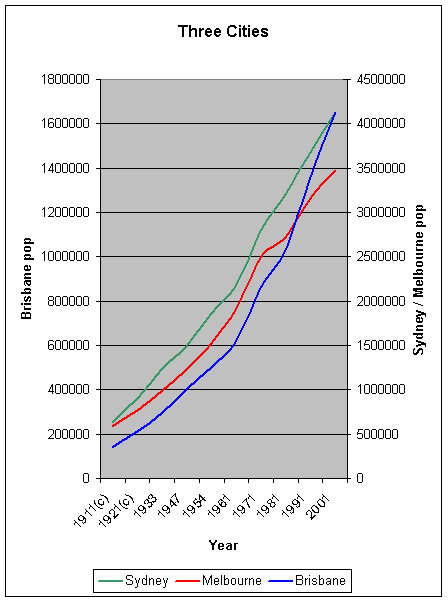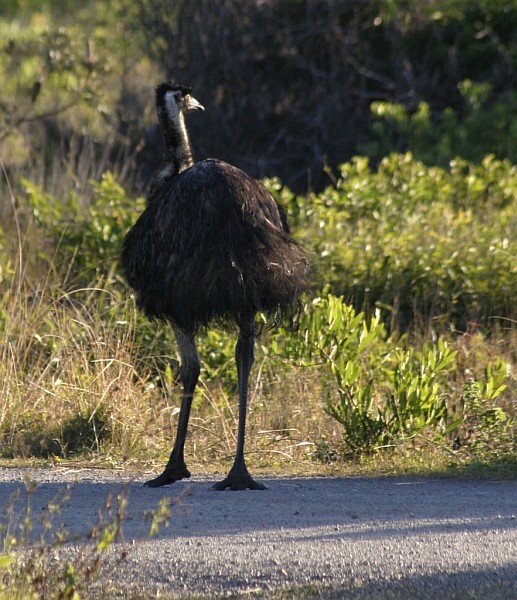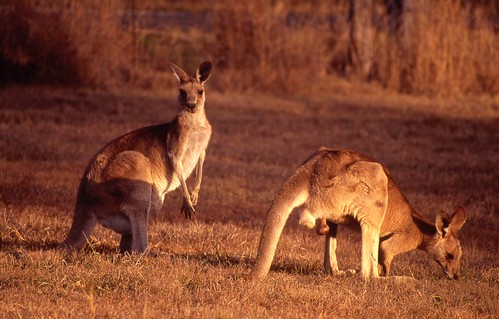Australia has significant population growth which can only do one thing when it come to housing: require more of it.
Some sources suggest that our population is "growing the fastest since the 1960s and double the global average. Net immigration accounted for two-thirds of this people boom".
According to that we had 511,000 new arrivals last financial year. Give or take, that's a population the size of the Gold Coast just sprouting up.
No wonder there is pressure on housing. I heard recently from a friend of mine that its common practice in some parts of Australia for landlords to require 4 months rent in advance on propertys.
There is the viewpoint that we need to grow our population in Australia, this seems popular among the 'leadership' who live in cities and seem to be unable to grasp the broader issues.
Land clearing causing destruction of Koala habitat in the name of further urban sprawl are simply "problems" which need creative solutions. The trouble is that there are usually no solutions and problems roll and expand on while lots of hot air gets expelled discussing "we need to solve these problems".
This seems to be creating a groundswell of 'grass roots' negativity expressed in the "fuck off we're full" stickers adorning the bumpers of "utes". While this is hardly helpful, it is a strong indicator of problems.
This is the growth in the population of 3 major cities since between 1911 and 2001.
 These three cities account for nearly half the Australian population.
These three cities account for nearly half the Australian population.To explain the graph a little I put Brisbane on a different scale to the others because unlike Sydney or Melbourne (which over the period have increased in population by around six times) Brisbane has had its population grow by nearly twelve times since 1911 (From 139,480 to 1,650,422)
This represents a startling management challenge, which I think anyone who lives in these cities may feel has not been entirely well performed.
Also, anyone who lived in any of these cities has seen amazing changes in how life is in those cities every 10 years.
When I moved to Brisbane in 1983 it was a nice but largeish country town. There was not insane traffic and you could get out into the countryside quite easily.
At that time the population was 1,028,527 ... but when I left in 2001 it had swollen to 1,619,280 and you could really notice the difference. Traffic was worse, public attitude was more strained and road rage and other less than ideal social problem was on the rise ... so lifestyle was certainly not better.
I imagine Sydney has undergone similar changes (although perhaps not as straining as Brisbane), and watching any movie filmed on the streets of Sydney in the 1980's reveals quite a difference.
But I wonder if this is in our interests in Australia ... I mean really.
Firstly Australia has a really poor record of environmental management, and I'm not just talking about how we manage our natural heritage (which should be a national shame), I am talking about how we've been managing our agriculture and forestry practices. Look at the Murray Darling crisis for just a start.
Our politicians espouse protecting our lifestyle, but seem to be busily facilitating its erosion.
If you like fishing, you can kiss good by to this area as the great fishing spot it once was ... mangroves are going and so too are the breeding grounds for fish. Not to mention the increased pressure on fishing created by the increasing population. As boat traffic is manic (along with the jetSki's I can't even enjoy sailing there anymore.
The urban sprawl is encroaching inland too, and what were previously lovely areas (habitat for wildlife) are being cleared to become just another urban wasteland.
Its like this all up and down the coast, from Coffs Harbour to Rainbow beach. Matter of fact its pretty built up between Coffs and Sydney ... and I'm willing to bet its not empty between Sydney and Melbourne?
 Used to be that my family and I could live in a place where we could go fishing and enjoy walks along the shore.
Used to be that my family and I could live in a place where we could go fishing and enjoy walks along the shore.Photographs like this were of a lifestyle we enjoyed as recently as 10 years ago, but is now fading into memories.
Once we could find wildlife not far from our homes ... now we seem to live in urban enclaves which have streets that are empty of humans and are filled cars instead. This has a number of impacts, including that our children can't ride bicycles to school and mum needs to start the Prado up to take them 2Km to school.
Sights like this emu walking along a country road (once familiar to my parents) are almost impossible to see.

this image was taken in a park just out of Ipswich ... there will not be any Roos there now as its in the middle of an urban sprawl now.

Our lifestyle is fast disappearing ... my question is
"what are we doing to ourselves and for what benefit?"

Basically the question is "Is it acceptable to transform non human habitats into human habitats?". I kind of think it is, being a human, but I won't say it comes without a cost.
ReplyDeleteif that's the question, but what if the question is "is it acceptable to turn my human habitat into one that I don't like without my permission or consent?"
ReplyDeletehow does all this make the quality of our lives better?
Around my place I now have more bogans in noisy cars doing "street racing" and hooning about. I get more drunken louts fighting in my street and I have some asshole across the road in the flats there who likes doing kareoke till 2am
they are in theory human too